
The Promise of Ivermectin: A Game Changer in Malaria Control
In a groundbreaking study conducted in coastal Kenya, a cluster-randomized trial has revealed that mass administration of ivermectin could significantly reduce the incidence of malaria among children aged 5 to 15 years. This comes at a pivotal moment in the global fight against malaria, where traditional insecticide-based interventions face increasing challenges due to rising resistance from the anopheles mosquito, the primary vector of the disease.
Understanding the Trial: Key Findings
Conducted across 84 community clusters involving nearly 29,000 participants, the trial compared the malaria incidence among children in two groups—one receiving ivermectin and another receiving albendazole. The results were promising: the incidence rate of malaria stood at 2.20 per child-year at risk in the ivermectin group compared to 2.66 in the albendazole group. This represents a substantial reduction of about 26% in malaria infections, exceeding the World Health Organization's minimally required criterion for intervention effectiveness.
Broader Implications of Ivermectin
Beyond its impact on malaria, the use of ivermectin carries potential collateral benefits in areas where other neglected tropical diseases, such as scabies and filariasis, are prevalent. Dr. Carlos Chaccour and colleagues emphasizing this point noted that ivermectin acts as an oral endectocide, which effectively targets parasites located both inside and outside human hosts.
Challenges in the Current Malaria Landscape
This innovative method of vector control comes at a time when global public health funding is experiencing extremist cuts. According to Richard Steketee, former deputy coordinator of the President's Malaria Initiative, the truncation in financial resources has led to widespread devastation of existing malaria programs across Africa, Asia, and the Americas. This trial highlights ivermectin's potential as a cost-effective solution amidst these funding challenges, providing a new avenue for malaria prevention.
A Call for Further Research and Implementation
While the results are encouraging, Steketee advocates for further research on longer-acting endectocides and the exploration of strategies to enhance the delivery of ivermectin across populations. Recommendations include incorporating home-based repellent diffusers and creating robust community awareness programs to optimize the impact of this treatment.
The Global Malaria Challenge: A Reality Check
In 2022, there were an alarming 249 million malaria cases and 608,000 related deaths, demonstrating the urgent need for effective intervention strategies. The historical efforts have significantly diminished malaria's burden in Africa—by 81% from 2000 to 2015—but the rising resistance among mosquitoes poses a dire threat to ongoing progress. Ivermectin's introduction could be a pivotal point in reversing this trend.
Practical Insights for Healthcare Professionals
For healthcare providers, understanding the intricacies of ivermectin's role in malaria control is crucial. Staying informed about such clinical breakthroughs not only enriches practice knowledge but also ensures that patients receive the best available care. It’s essential for providers to engage in continuing medical education, exploring new medical studies, and participating in discussions revolving around healthcare innovation.
Conclusion: A Unified Approach Against Malaria
The findings from this trial underscore the significance of diverse approaches when tackling complex health challenges like malaria. In an era of financial constraints and evolving disease dynamics, solutions like mass ivermectin administration can be emblematic of innovative healthcare pathways. By joining forces and sharing knowledge, the global health community can effectively combat this enduring threat.
To stay updated on the latest medical news and clinical research updates, embrace continuing medical education opportunities to enhance your understanding and practices in disease management.
 Add Row
Add Row  Add
Add 




Write A Comment